Rupa tells us about snake worship and its relevance in our scriptures. An exclusive for Different Truths.
 Why do Hindus deify snakes? What days are designated to offer prayers to our scaly friends and co-habitats?
Why do Hindus deify snakes? What days are designated to offer prayers to our scaly friends and co-habitats?
Naag Chaturthi or Nagula Chavithi (Telugu) is considered an auspicious day to observe Naag Puja. It is observed on the fourth day (Chaturthi) after Deepavali Amavasya during Kartika month. Naag Panchami and Naag Sashti are observed after Naag Chaturthi. In some parts of Andhra Pradesh and Tamilnadu it is also celebrated in the Sravana month.
During the festival, women fast, devotees offer milk and dry fruits to Sarpa Devata at the Valmeekam or Putta (snake pits).
This is a festival to worship Naag Devatas (Serpent Gods), mainly followed by women for wellbeing of children. During the festival, women fast, devotees offer milk and dry fruits to Sarpa Devata at the Valmeekam or Putta (snake pits). Ashtanaag (seven hooded cobra) is worshipped.
Some people place Naag Devata idol at home and perform puja. But in some places, devotees go to ‘Putta’ (Snake pit) and offer Naivedyam and perform other pujas there
The popular legend associated with Nagula Chavithi in Hindu culture suggests that on the day Lord Shiva drank the poison Halahala or Kalkuta to save the universe during the famous incident of Samudra Manthan.
The popular legend associated with Nagula Chavithi in Hindu culture suggests that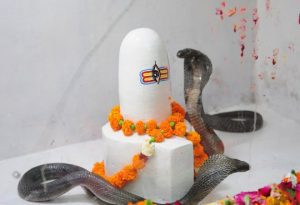 on the day Lord Shiva drank the poison Halahala or Kalkuta to save the universe during the famous incident of Samudra Manthan. Pujas and prayers are held in Naag temples across the state.
on the day Lord Shiva drank the poison Halahala or Kalkuta to save the universe during the famous incident of Samudra Manthan. Pujas and prayers are held in Naag temples across the state.
Nowadays, Nagula Chavithi day is noted for the practice of offering milk and eggs to the snakes, especially cobras, near snake pits. Snake charmers also bring cobras to villages and towns which are fed with milk by devotees.
As it is believed that snakes have more powers than humans and on account of its association with Shiva, Devi, Vishnu and Subramanya, a degree of fear is instilled resulting in deification of the cobra
As it is believed that snakes have more powers than humans and on account of its association with Shiva, Devi, Vishnu and Subramanya, a degree of fear is instilled resulting in deification of the cobra and its worship throughout the country by Hindus.
Snake has connotation with the Moon’s nodes known in Hindu astrology. The head of the snake is represented by Rahu (Dragon’s head) and its tail by Ketu (Dragon’s tail). If in the zodiacal chart of an individual all the seven major planets are hemmed between Rahu and Ketu in the reverse order (anticlockwise) it is said to denote Kalasarpa dosha (defect due to black snakes), which forebodes ill luck and hardship in an individual’s life and therefore appeased by offering worship to the snakes
Indian scriptures such as Agni Purana, Skanda Purana, Narada Purana and the Mahabharata give details of history of snakes
Indian scriptures such as Agni Purana, Skanda Purana, Narada Purana and the Mahabharata give details of history of snakes, extolling their worship.
Sarpa Satra, the snake sacrifice where Astika, young Brahmin stops the yagna.
In the Mahabharata epic, Janamejeya, the son of King Parikshita of the Kuru dynasty was performing a snake sacrifice known as Sarpa Satra, to avenge for the death of his father from a snake bite by the snake king called Takshaka. A sacrificial fireplace had been specially erected and the fire sacrifice to kill all snakes in the world was started by a galaxy of learned Brahmin sages. The sacrifice performed in the presence of Janamejaya was so powerful that it was causing all snakes to fall into the Yagna kunda (sacrificial fire pit). When the priests found that only Takshaka who had bitten and killed Parisksihita had escaped to the nether world of Indra seeking his protection, the sages increased the tempo of reciting the mantras (spells) to drag Takshaka and also Indra to the sacrificial fire.
Takshaka had coiled himself around Indra’s cot but the force of the sacrificial yagna was so powerful that even Indra along with Takshaka were dragged towards the fire.
Takshaka had coiled himself around Indra’s cot but the force of the sacrificial yagna was so powerful that even Indra along with Takshaka were dragged 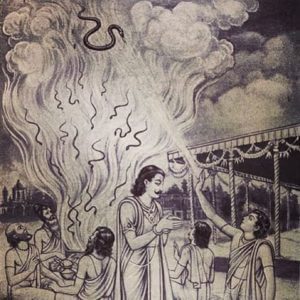 towards the fire. This scared the gods who then appealed to Manasadevi to intervene and resolve the crisis. She then requested her son Astika to go to the site of the yagna and appeal to Janamejaya to stop the Sarpa Satra yagna. Astika impressed Janamejaya with his knowledge of all the Sastras (scriptures) who granted him to seek a boon.
towards the fire. This scared the gods who then appealed to Manasadevi to intervene and resolve the crisis. She then requested her son Astika to go to the site of the yagna and appeal to Janamejaya to stop the Sarpa Satra yagna. Astika impressed Janamejaya with his knowledge of all the Sastras (scriptures) who granted him to seek a boon.
It was then that Astika requested Janamejeya to stop the Sarpa Satra. Since the king was never known to refuse a boon given to a Brahmin, he relented, in spite of protects by the rishis performing the yagna. The yagna was then stopped and thus the life of Indra and Takshaka and his other serpent race were spared. This day, according to the Hindu calendar, happened to be Nadivardhini Panchami (fifth day of bright fortnight of the lunar month of Shravana during the monsoon season) and since then the day is a festival day of the Naags as their life was spared on this day. Indra also went to Manasadevi and worshipped her.
According to the Garuda Purana, offering prayers to snake on this day is auspicious and it ushers good tidings in one’s life.
According to the Garuda Purana, offering prayers to snake on this day is auspicious and it ushers good tidings in one’s life. This is to be followed by feeding Brahmins.
Naag Panchami: Panchami is the fifth day among the fifteen days of the moon’s waxing and/or waning. This special day of the serpent worship always falls on the fifth day of the moon’s waning in the Lunar Hindu month of Shravana July/August. Hence called Naag Panchami (Naga: cobra; or simply, serpent).
There are many legends in Hindu mythology and folklore narrated to the importance of worship of snakes.
According to Hindu Puranic literature and the Mahabharata, Kashyapa, son of the universal creator Lord Brahma, married two daughters of Prajapati, Kadru and Vinata.
According to Hindu Puranic literature and the Mahabharata, Kashyapa, son of the universal creator Lord Brahma, married two daughters of Prajapati, Kadru and Vinata. Kadru then gave birth to the race of Naags, while Vinata gave birth to Aruna, who became the charioteer of the sun god, Surya, and also birth to the great eagle Garuda, who became the carrier of Vishnu.
Naag Panchami is also a day when Akhara, traditional Indian wrestling gyms, hold special celebrations to honor the mystical symbolism of the snake as a symbol of virility and kundalini energy. As part of the festivities, a Naag or serpent deity made of silver, stone, wood, or a painting of snakes is given a reverential bath with milk and their blessings are sought for the welfare of the family. Live snakes, especially cobras, are also worshipped on this day especially with offerings of milk and generally with the assistance of a snake charmer.
Worship of Naags is a constant reminder to humans to live in harmony with nature.
Worship of Naags is a constant reminder to humans to live in harmony with nature. And the ideal way to worship Naags is by protecting the forests and grooves that are home of snakes and other animals.
Photo sourced by the author from the Internet

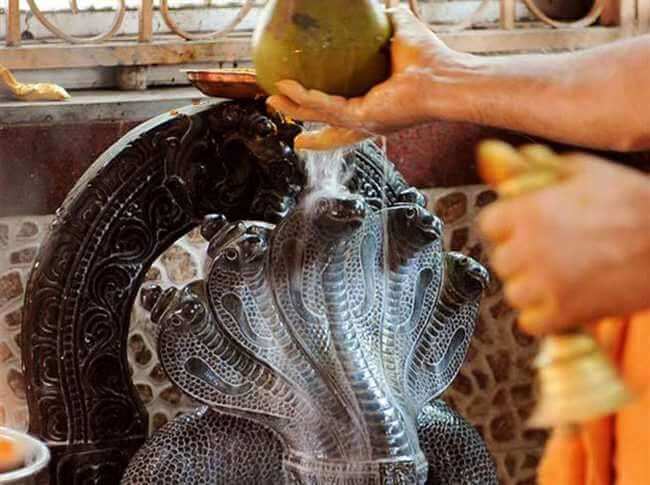
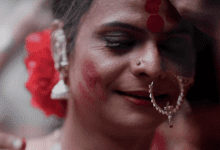

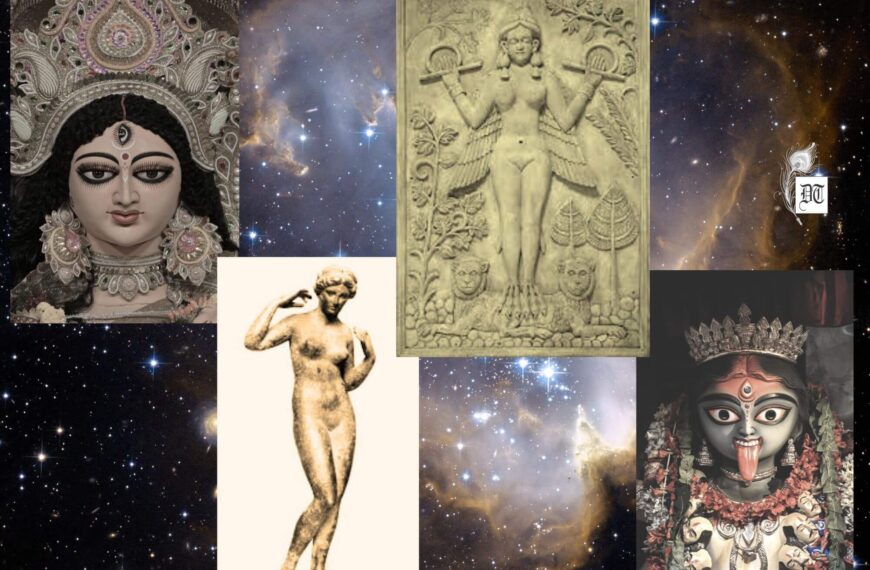
 By
By
 By
By
